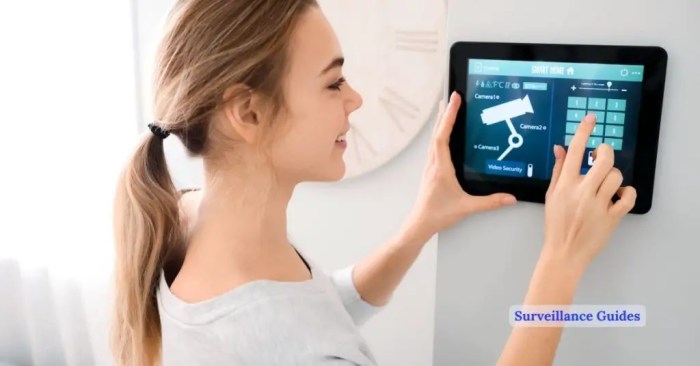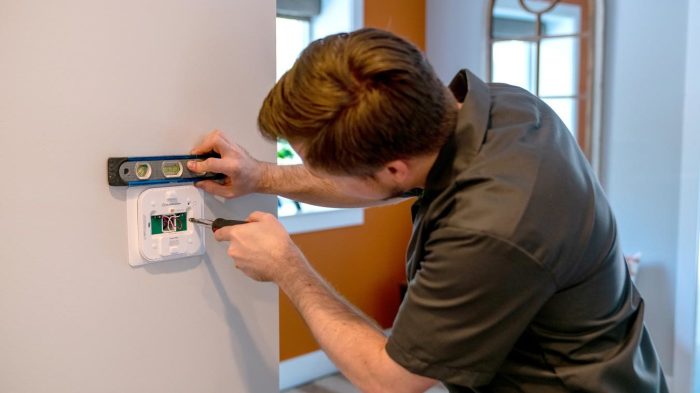Smart Security System Installation: Enhancing Home Safety and Protection

Embark on the journey of smart security system installation, where we delve into the realm of advanced technology that safeguards your home with precision and efficiency. Discover the key components, installation process, and integration possibilities that revolutionize home security.
Importance of Smart Security Systems
Installing a smart security system is crucial for protecting your home and loved ones. These systems offer a range of benefits that enhance overall safety and provide peace of mind.
Enhanced Home Safety
- Smart security systems allow you to monitor your home remotely, providing real-time alerts and updates on any suspicious activity.
- Integration with smart devices like cameras, sensors, and door locks ensures comprehensive coverage of your property.
- Access to live video feeds and notifications on your smartphone helps you keep an eye on your home even when you're away.
Deterrence of Burglaries and Intrusions
- The visible presence of cameras and sensors acts as a deterrent to potential intruders, reducing the risk of break-ins.
- Alarm systems linked to smart security devices alert authorities quickly in case of a security breach, increasing the chances of apprehending criminals.
- Data from smart security systems can also be used as evidence in investigations, aiding law enforcement in solving crimes.
Components of a Smart Security System

When setting up a smart security system, it is crucial to understand the key components that make up a comprehensive security setup. Each component plays a vital role in ensuring the safety and protection of your property.
Cameras
Cameras are one of the fundamental components of a smart security system. They provide visual surveillance of your property, allowing you to monitor any suspicious activities in real-time. High-definition cameras with night vision capabilities offer clear footage even in low light conditions.
Sensors
Sensors are another essential part of a smart security system. These devices can detect motion, entry, or environmental changes such as smoke or carbon monoxide levels. When triggered, sensors send alerts to the control panel, notifying you of potential security threats.
Control Panel
The control panel acts as the central hub of your smart security system. It connects all the components together and allows you to arm/disarm the system, view camera feeds, and receive notifications. The control panel is where you can configure settings and customize security preferences.
Smart Locks
Smart locks provide an additional layer of security by allowing you to remotely lock and unlock doors using a mobile app or keypad. You can also set up access codes for family members or trusted individuals, eliminating the need for physical keys.
By integrating cameras, sensors, control panels, and smart locks, a smart security system offers comprehensive coverage for your property. These components work together seamlessly to provide real-time monitoring, instant alerts, and remote access control, ensuring enhanced security and peace of mind.
Installation Process
When it comes to installing a smart security system, following a step-by-step process is essential to ensure proper functionality and effectiveness. Here, we will discuss the key steps involved in setting up your smart security system.
Tips for Positioning Cameras and Sensors
- Place cameras at entry points such as doors and windows to capture any potential intruders.
- Ensure cameras have a clear view of the area you want to monitor without any obstructions.
- Position motion sensors in high-traffic areas to detect movement effectively.
- Adjust the angle of cameras to avoid capturing unnecessary footage like the sky or ground.
Potential Challenges During Installation and How to Troubleshoot Them
- If cameras or sensors are not connecting to the system, check the Wi-Fi connection and restart the devices.
- In case of false alarms, adjust the sensitivity settings of the sensors to reduce triggering by pets or moving objects.
- If there are blind spots in the camera coverage, consider adding additional cameras or adjusting the angle for better visibility.
- If you face difficulties accessing the system remotely, ensure proper configuration of the app and internet connection settings.
Integration with Smart Home Technology

Smart security systems have the capability to integrate seamlessly with various other smart home devices, creating a connected ecosystem that enhances overall security and convenience for homeowners.
Advantages of Integration
- Increased Automation: By integrating with smart home devices such as lights, locks, and cameras, smart security systems can automate responses to security threats or emergencies. For example, if a motion sensor detects movement outside the house, the system can automatically turn on exterior lights and send a notification to the homeowner's smartphone.
- Enhanced Communication: Integration allows different devices to communicate with each other, providing a more comprehensive view of the home's security status. For instance, a smart doorbell camera can send a live feed to the homeowner's smartphone when someone rings the doorbell, enabling them to see and speak to the visitor from anywhere.
- Remote Access: With integration, homeowners can remotely control and monitor their security system through a single app on their smartphone or tablet. This convenience enables them to check on their home's security status, arm/disarm the system, and receive real-time alerts no matter where they are.
Examples of Automation
- Geofencing: Smart security systems can use geofencing technology to automatically arm or disarm the system based on the homeowner's location. When the homeowner leaves a predefined geofenced area around their home, the system arms itself, and disarms when they return.
- Integration with Voice Assistants: By integrating with voice assistants like Amazon Alexa or Google Assistant, homeowners can control their security system using voice commands. They can arm/disarm the system, check the status of sensors, or even play back security camera footage hands-free.
Final Wrap-Up
In conclusion, smart security systems offer a cutting-edge solution to fortify your home against potential threats. With seamless integration and top-notch components, you can rest assured that your safety is prioritized. Upgrade to smart security today and experience a new level of peace of mind.
Frequently Asked Questions
What are the benefits of installing a smart security system?
Smart security systems offer advanced features like real-time monitoring, remote access, and customization options, enhancing overall security and peace of mind.
How do smart security systems deter burglaries and intrusions?
Smart security systems with visible cameras and sensors act as a deterrent to potential intruders, alerting homeowners and authorities in case of any suspicious activity.
What are the key components required for a smart security system installation?
Key components include cameras, sensors, control panels, and smart locks, each playing a crucial role in ensuring comprehensive security coverage.
How can smart security systems integrate with other smart home devices?
Smart security systems can seamlessly integrate with devices like smart lights, thermostats, and doorbell cameras, creating a connected ecosystem that enhances overall security and convenience.
What are some potential challenges during smart security system installation?
Potential challenges may include connectivity issues, positioning cameras effectively, and troubleshooting sensor malfunctions. These challenges can be addressed with proper guidance and support.




